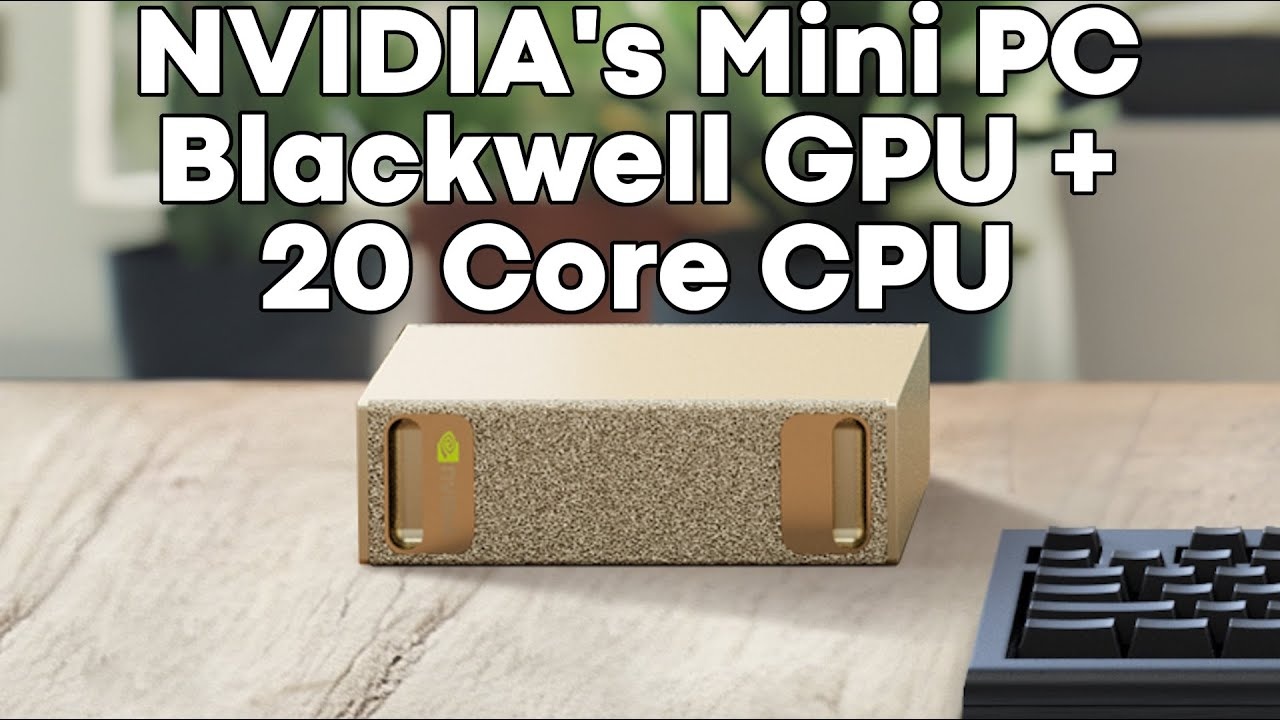
Introduction
At the Consumer Electronics Show (CES) in Las Vegas, NVIDIA unveiled their groundbreaking Project Digit—an innovative Mini PC powered by their cutting-edge GB10 Grace Blackwell superchip. This meticulously engineered system, which combines exceptional processing capabilities with a space-efficient design, represents NVIDIA’s inaugural entry into the realm of workstation-class Mini PCs. The device has been specifically architected to excel in artificial intelligence and machine learning applications, offering unprecedented computational power in a remarkably compact form factor.
Nvidia GPU, Project DIGITS, and AI Mini PCs
Nvidia GPUs are powerful graphics processing units (GPUs) that have become essential tools for artificial intelligence (AI) and deep learning. Their parallel processing architecture makes them ideal for handling the complex computations involved in training and running AI models.
Project DIGITS is a groundbreaking initiative by Nvidia that aims to democratize access to high-performance AI computing. It involves creating a personal AI supercomputer, compact and affordable, designed for individual developers, researchers, and students. This device, powered by Nvidia’s Grace Blackwell Superchip, offers petaflop AI computing performance, enabling users to prototype, fine-tune, and run large AI models locally.
AI Mini PCs are compact computers specifically designed for AI tasks. They often feature powerful processors, ample memory, and dedicated AI accelerators like Nvidia GPUs. These devices are becoming increasingly popular for researchers, developers, and businesses looking to leverage AI technologies.
Here’s a visual representation of the relationship between these concepts:
- Nvidia GPUs are the powerhouse behind AI advancements, providing the computational muscle needed for training and running AI models.
- Project DIGITS represents Nvidia’s commitment to making AI accessible to everyone, offering a personal AI supercomputer that can handle complex AI tasks.
- AI Mini PCs are compact devices that leverage Nvidia GPUs and other AI accelerators to provide powerful AI capabilities in a small form factor.
By combining these technologies, Nvidia is paving the way for a future where AI is more accessible and integrated into various aspects of our lives.
Video about NVIDIA’s Mini PC:
Key Features and Specifications
- Processor: GB10 Grace Blackwell superchip
- CPU: 20-core ARM-based configuration
- 10 Cortex X925 CPU cores
- 10 A725 CPU cores
- Memory: 128GB unified coherent memory
- Storage: Up to 4TB NVMe
- AI Performance: 1 Petaflop at 4-bit precision
- OS: NVIDIA DGX OS Linux (Ubuntu-based)
- GPU: Latest NVIDIA Blackwell architecture with 5th generation tensor cores
- NVLink chip-to-chip interconnect
Technical Capabilities
- Can run 200 billion parameter large language models (with 4-bit quantization)
- Full compatibility with NVIDIA’s AI software stack
- Supports remote desktop and secure shell connections
- Designed for data science and machine learning workloads
Development and Partnerships
- Collaboration with MediaTek on system design
- Built as part of NVIDIA’s DIGITS (Deep Learning GPU Intelligence Training System) project
- Expected release: May 2024
- Starting price: $3,000
Market Positioning
- Targeted at AI developers and researchers
- Significantly more affordable than full DGX systems
- Not intended as a consumer Windows PC replacement
- Fills a niche between consumer PCs and enterprise DGX systems
NVIDIA Jetson Orin Nano Super vs. DIGITS AI Mini PCs
NVIDIA Jetson Orin Nano Super and DIGITS AI Mini PCs are both powerful platforms for AI development and deployment, but they cater to different needs and offer distinct advantages.
NVIDIA Jetson Orin Nano Super
- Focus: Embedded and edge AI applications.
- Form Factor: Compact, credit-card-sized module.
- Key Features:
- High-performance NVIDIA Ampere architecture.
- Up to 1024 CUDA cores.
- Up to 16GB LPDDR5 memory.
- Supports multiple sensors and interfaces.
- Low power consumption.
- Ideal for:
- Robotics and autonomous systems.
- Smart IoT devices.
- Computer vision applications.
- Edge AI inference and training.
DIGITS AI Mini PCs
- Focus: Personal AI supercomputing.
- Form Factor: Desktop-sized form factor.
- Key Features:
- Powered by the Grace Blackwell Superchip.
- Petaflop AI performance.
- 128GB unified memory.
- Supports advanced AI frameworks and tools.
- Ideal for:
- Developers and researchers.
- Prototyping and fine-tuning large AI models.
- Running demanding AI workloads locally.
Here’s a table summarizing the key differences:
| Feature | Jetson Orin Nano Super | DIGITS AI Mini PC |
|---|---|---|
| Focus | Embedded and edge AI | Personal AI supercomputing |
| Form Factor | Compact module | Desktop-sized |
| Processor | NVIDIA Ampere architecture | Grace Blackwell Superchip |
| Memory | Up to 16GB LPDDR5 | 128GB unified memory |
| Performance | High-performance for embedded AI | Petaflop AI performance |
| Ideal Use Cases | Robotics, IoT, computer vision | Prototyping, large model training, demanding AI workloads |
In essence, the Jetson Orin Nano Super is ideal for resource-constrained, power-efficient AI applications at the edge, while the DIGITS AI Mini PC is designed for high-performance AI computing on a desktop.
Which one is right for your project?
- Choose the Jetson Orin Nano Super if:
- You need a compact and power-efficient solution for embedded or edge AI.
- You’re working on robotics, IoT, or computer vision projects.
- You require support for multiple sensors and interfaces.
- Choose the DIGITS AI Mini PC if:
- You need a powerful desktop AI workstation.
- You’re working on large AI models or demanding AI tasks.
- You require high performance and access to advanced AI tools.
Conclusion
Market Impact & Innovation
The introduction of Project Digit represents a significant milestone in AI computing, bridging a crucial gap between consumer-grade AI development machines and enterprise-level DGX systems. NVIDIA’s decision to enter the Mini PC market with such a powerful system signals a growing demand for accessible yet powerful AI computing solutions.
Technical Achievement
The GB10 Grace Blackwell superchip demonstrates remarkable engineering, packing enterprise-level AI capabilities into a compact form factor:
- The ability to handle 200B parameter models represents a 28x increase over what’s possible with current desktop solutions
- The unified memory architecture and NVLink interconnect show NVIDIA’s focus on optimizing AI workload performance
- The heterogeneous 20-core ARM CPU configuration (10 X925 + 10 A725) balances performance and efficiency
Competitive Landscape
When compared to existing solutions:
vs. NVIDIA Jetson Orin Nano Super
- 10x higher performance capability
- 8x more memory capacity
- 30x larger model handling capability
- Different target market and use cases
vs. Traditional Desktop AI Solutions
- More integrated and optimized for AI workloads
- Better memory coherency and bandwidth
- Full DGX software stack compatibility
- Smaller form factor
vs. Full DGX Systems
- More affordable entry point
- Maintains software compatibility
- Sacrifices raw performance for accessibility
- Better suited for individual developers and small teams
Strategic Implications
- Industry Partnerships: The collaboration with MediaTek suggests potential future developments in ARM-based computing solutions and could indicate NVIDIA’s broader strategy for the PC market.
- Developer Ecosystem: By providing DGX OS Linux compatibility, NVIDIA ensures a seamless transition path from development to enterprise deployment.
- Market Positioning: The $3,000 price point, while significant for individuals, represents an accessible entry point for organizations requiring AI computing capabilities.
Future Potential of Project Digits
The Project Digit platform could:
- Enable more widespread adoption of large language model development
- Serve as a foundation for future ARM-based workstations
- Drive innovation in compact, high-performance computing solutions
- Foster new applications in AI research and development
Limitations & Considerations
- Fixed memory configuration may limit some use cases
- Price point still presents a barrier for individual developers
- May require specific cooling solutions (not detailed in announcement)
- Limited storage expandability due to integrated design
Final Assessment about Project DIGITS:
Project Digit represents a bold step forward in democratizing AI computing capabilities, offering a compelling balance of performance, form factor, and price. While not a solution for everyone, it fills a crucial market gap and could potentially reshape how AI development is approached at the mid-range level. The system’s ability to handle substantial AI models while maintaining a relatively accessible price point makes it a significant addition to NVIDIA’s AI computing ecosystem, complementing rather than replacing existing solutions like the Jetson series.
This launch also signals NVIDIA’s understanding of the evolving AI development landscape, where there’s growing demand for powerful, dedicated AI computing solutions that don’t require enterprise-level investment or infrastructure. The collaboration with MediaTek and the choice of ARM architecture further suggests this could be part of a larger strategy to reshape the workstation computing market.
Key Takeaways
- NVIDIA’s Project Digit represents a significant step in bringing supercomputer-class AI capabilities to a Mini PC form factor
- The $3,000 price point, while high for consumers, is relatively accessible for professional AI development
- The collaboration with MediaTek suggests potential future developments in the ARM-based PC market
- The system’s ability to run 200B parameter models sets it apart from current desktop AI solutions
Related References
- NVIDIA DGX systems
- ARM Cortex X925 and A725 architectures
- NVIDIA Blackwell GPU architecture
- CUDA and Tensor core technologies
- MediaTek’s ARM-based computing initiatives
- Jetson Developer Portal
- NVIDIA JetPack SDK Documentation
- Jetson Orin Technical Reference Manual
- NVIDIA Jetson Orin Nano Series Documentation
- NVIDIA Jetson Product Comparison Matrix
- NVIDIA Jetson Linux Driver Package
This significant development in bringing enterprise-level AI capabilities to a more compact and relatively affordable form factor, though still clearly positioned for professional use rather than consumer applications.




I just like the valuable info you supply in your articles.
I will bookmark your weblog and take a look at again right here
regularly. I am moderately sure I’ll be told many new stuff right right here!
Best of luck for the following!
If you are going for most excellent contents like myself, just
go to see this website every day since it offers quality
contents, thanks
Feel free to surf to my website: y2video downloader